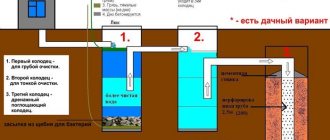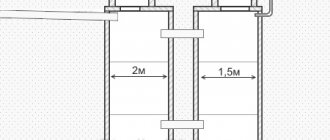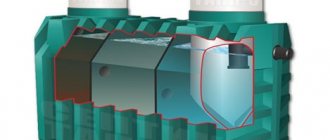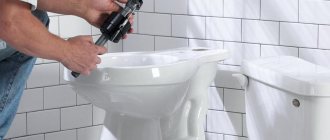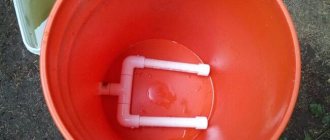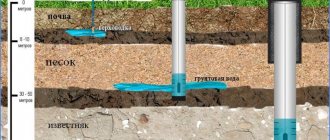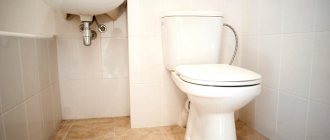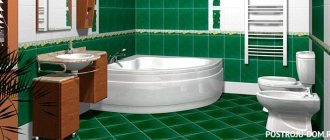There is no doubt that it is impossible to live without a toilet in the countryside. However, when building such structures far from civilization, difficulties arise. Connection to local treatment facilities is excluded due to their remoteness. Therefore, you have to build a toilet, relying only on your own strength, because not everyone can afford an autonomous sewer system. There are two options left: build a regular closet with a cesspool or buy a dry closet. The second option is much more environmentally friendly and has minimal disadvantages. However, it will cost more. Why not build a dry closet for your dacha with your own hands and save money?
- 2 Where is the best place to install it?
- 3 How to build a seat with a container?
- 4 Rules for using a dry toilet
4.1 Is drainage required for this design?
- 4.2 Proper waste disposal
The principle of operation of toilets using peat components
Ordinary peat is used as a filler for dry toilets.
The active substance in the form of peat filler has excellent absorption. It is capable of absorbing large amounts of waste. Moreover, this ability is expressed in specific proportions - just one kilogram of peat easily absorbs 10 liters of waste! In the process of processing liquid waste with the participation of peat, compost is formed that is beneficial for soil fertility. This kind of home compost production is very important for summer residents, especially since it almost completely eliminates the smell from processed products and preserves useful components.
Externally, the Finnish peat toilet for a summer residence resembles a regular toilet, however, its formats can be arbitrary. Also, the dimensions of the dry closet also vary.
The main factors affecting the operation of a peat toilet
Since the process of compost formation occurs due to the activity of bacteria, its course is influenced by certain biological factors.
- The presence of oxygen is ensured by ventilation. It also removes unpleasant odors. It is also worth noting that the intensity of the odor is much lower if an optimal mode of the composting process is created.
- The moisture contained in excrement and urine is excessive, so additional liquid should not be allowed into the composting toilet. Excess moisture can be reduced in various ways:
- ventilation,
— arrangement of evaporation chambers (applicable for large containers),
— separation of flows (some purchased eco-toilets for summer cottages have a separate discharge of the liquid component, leaving only solid waste for compost formation),
- using fillers (in addition to peat, sawdust, shavings, coconut fiber, ash, lime mixed with soil, etc. are used in this capacity).
- High temperature helps reduce the decomposition time of waste, so purchased designs often have a thermometer for monitoring. They are also often used to equip large continuous composting toilets, the operation of which is difficult to control due to the large volume of the storage tank.
What designs of toilets for summer cottages exist?
Such buildings can be divided into several varieties suitable for a summer residence:
- toilet house with cesspool;
- standard powder closet;
- factory biotool.
Toilet house with cesspool
For such a structure, a foundation pit is first dug. Then they build a cesspool by strengthening the walls with concrete rings, bricks, monolithic concrete, or installing a plastic container in the pit.
A toilet house made from scrap material is installed above the pit, in which a pedestal or toilet seat is placed. Such a toilet design for a summer house involves the accumulation of waste in a cesspool.
To eliminate the smell spreading from the cesspool, install a ventilation pipe
If the structure is not sealed, liquid waste partially seeps into the soil or evaporates.
Filling a sealed pit occurs faster. When sewage reaches a certain level, it has to be removed. Cleaning is carried out either independently using a pump, or by calling a sewer truck.
Powder closet - a house without a cesspool
A house is also built for a powder closet, but without a cesspool. In this version of the country toilet, waste is collected in a container located under the toilet seat.
For greater convenience, two “different-sized” tanks are installed. Small holes are made in the smaller one and inserted into the larger one, on the side of which a round outlet is made and a drainage hose is installed. It will drain excess liquid into the ground or into the drainage system.
A container for the filler is placed next to the toilet seat. This could be sawdust, peat or dry soil.
Despite the fact that the filler partially suppresses odors, the powder closet requires the installation of a ventilation pipe
After visiting the toilet, the waste is sprinkled with litter. This reduces unpleasant odors and promotes the decomposition of sewage. As the tank fills, it is taken to the compost heap.
The scheme for constructing a powder-closet-type toilet in a country house should take into account the method of obtaining the container. Basically there are only two of them. In the first case, the reservoir is removed from the toilet seat by lifting the seat.
In the second, a small door is built at the back of the building, by opening which you can remove the drive.
If you don’t want the hassle, buy a dry closet
For those who do not have the desire or time to build a toilet, there are ready-made products. Manufacturers of dry closets have already taken care of everything. All you have to do is choose the appropriate option and install it in your room or house. If funds allow, you can buy a toilet along with a stall.
Whatever type of toilet is chosen, it is advisable to begin its construction by drawing up a diagram. It is necessary to indicate the dimensions of the structure and the location of all components. For example, the construction plan for a country toilet with a cesspool should be drawn up taking into account the width and depth of the pit.
Operating principle of the toilet
The device is a biological type toilet, because chemical reagents are not used to process waste. Peat enriched with microorganisms is poured into the reservoir. Decomposition occurs aerobically. The toilet does not emit a stench; it can be placed indoors. Toilet filler is filled using a special handle; it fills the container evenly because it turns in all directions.
What do they put in the dry closet?
Just peat cannot be used for backfilling; it does not contain a large number of bacteria. You should purchase special formulations with microorganisms that break down waste. If the volume of the toilet does not exceed fifty liters, then a peat filler is suitable. If the volume is larger, then use sawdust and peat mixed. Sawdust has a high level of breathability, and the process of converting waste into fertilizer is accelerated.
Attention! It is not recommended to use peat from the garden for the toilet; the purchase of special mixtures based on peat is required.
Toilet arrangement
The best option for a dry closet on peat is considered to be a structure within which the liquid sewage and its solid component are divided.
Liquid waste is removed through a drain in the form of a ditch. At the same time, all odors disappear as they pass through the fillers. If you rarely use the dry closet, for example, when you come to the dacha on weekends, then drainage is not needed. The filler will cope with liquid inclusions on its own, decomposing it. When using a toilet, drainage is constantly required. In this case, the liquid enters the filtration system through a hose, where, after being purified at several levels, it flows out into a drainage ditch, or into a septic tank or compost pit.
If the toilet is manufactured at a factory, then the sewage is divided into fractions based on density. If the toilet is made by hand, then there is no filtration system, it is very difficult. Liquid fractions flow down the hose. Compost is formed from solid waste with the help of bacteria inside the container. The reservoir should be emptied of fertilizer by disposing of the contents into a compost container. It is not yet possible to fertilize with this compost, because the decomposition process is not completely completed; the cycle lasts for two to three years. The container must be cleaned depending on how full it is, at least once a week.
Attention! The storage container is heavy, so you can attach wheels to avoid carrying it. You should not wait until the toilet is completely filled, otherwise the mass will be compressed and it will be difficult to pull it out.
How to arrange ventilation
This type of toilet requires ventilation. Odors can penetrate from the toilet into the room and into the environment. Microorganisms cannot process waste very quickly. In order for bacteria to multiply inside a container, oxygen is required. The ventilation pipe should protrude strictly vertically above the toilet, because the slope reduces the level of air draft.
If you rarely use the toilet, you can install a pipe with a thickness of forty milliliters to ensure natural ventilation. If many people live in a house, then a pipe with a diameter of one hundred millimeters will be required. You will also need to build an axial fan for forced ventilation.
Installation of a dry toilet
The simplest option is to purchase a portable chemical toilet with replaceable cassettes. You will need to insert the cassette or fill the reservoir with concentrate and select a suitable location for the toilet.
The location can be chosen based on personal preference, since there is no need to be tied to a cesspool. In addition, you don’t have to worry about groundwater contamination (with the exception of portable toilet models with chemical filler). The smell will be present, but not strong, but barely perceptible - this is a completely natural process. If you do everything according to the rules, then you can install a dry closet at home, only then you need to take care of the ventilation and drainage system. Taking into account all these nuances, you can choose a suitable location and begin installation.
How to install a dry closet at your dacha:
- If you have chosen a portable toilet with cassettes (cleaning with chemicals), then you need to remove the protective film from the toilet and assemble the structure.
- You need to insert a cassette with liquid or pour liquid concentrate into a special compartment, snap the lid on and place the upper bowl with the lid.
- Don't forget to check how the toilet works in action.
- If you are satisfied with everything, you can install the portable toilet in a permanent place.
- Do a test rinse. The waste should move to the lower storage tank.
- When the tank is full, you need to remove it and press the reset button (the pressure will drop and the tank will be empty of its contents).
- Then you need to wash the container and fill it with water again, add the biological product.
- If you bought a dry toilet with a volume of 12 liters, it means that after approximately 35 visits (for 1 person this is a week of visits), you need to clean the tank; a tank volume of 21 liters is enough for 70 visits (2 weeks of use).
- There are models equipped with a tank full indicator and a pump for convenient operation.
If you want to tinker a little, you can make a peat biotoilet yourself. You need to prepare all the materials and you can start working.
What you will need:
- plastic or metal container for peat;
- seat (toilet, container or bucket);
- dry peat;
- compost pit.
To make it more convenient to use the toilet, you can place a bucket of peat next to the toilet and add a new portion of the filler after each visit. Before using the toilet for the first time, you need to pour a little peat into the bottom of the container, then the feces will be cleaned well and quickly.
The design of the dry closet is simple: you need to install a bucket or other suitable container, pour a little peat mixture into it, install a toilet seat on top and attach a lid. Now you can use the dry closet. As soon as the bucket is full, the mixture should be poured into the compost pit.
Dry toilet for a summer residence. Video:
Details. Types of peat toilets
There are several types of dry closets. Toilets with a long waste treatment period. The waste is often removed and placed in a container for fertilizer, where it ripens for several years. This bathroom can be built independently. Dry toilets with a continuous composting process. The container is emptied several times a year, and the compost immediately goes to work. This requires complex structures that are expensive. You can't make them yourself. There are dry toilets that are installed at home either outside, or combined devices: the toilet is located in a special room, ventilation with a container is outside.
Attention! The combined option is considered convenient because waste can be immediately disposed of outside.
Peat dry toilet using a bucket
The method of organizing a toilet is cheap and easy to implement. These qualities can be attributed to the positive properties of the design. The disadvantages include frequent cleaning of the bucket, odors emanating from waste, so the device cannot be kept indoors for a long time.
To make a toilet you will need:
- 1. the presence of a bucket, a tank of a sealed design, having a volume of over twenty liters and a lid. The best solution would be to use a toilet made of plastic material because it is easy to clean, unlike metal. A plastic bucket is suitable for a summer house.
- 2. a wooden box for a bucket filled with peat, waste. This box is easy to construct from plywood ten millimeters thick. The material requires treatment with compounds that protect against moisture.
- 3.presence of a box for peat mixture.
- 4.seat.
- 5. jigsaw with electric saw.
- 6.self-tapping screws with a screwdriver.
- 7.small metal hinges to connect the lid to the toilet body.
Attention! You can choose a place for a dry toilet in the entryway of the dacha, or in a closet, or you can use a booth on the site.
Instructions for installing a toilet with a bucket
The walls for the box with a lid are made from plywood sheets. The height of the walls should be equal to the height of the bucket. There are 5 walls in total. Using a jigsaw, make a hole on the surface of the lid equal to the diameter of the container. Saw off four pieces of bars using a wooden beam measuring 50 by 50 millimeters. The bars are attached to the walls with self-tapping screws. The lid is placed on hinges and connected to the box from above. The toilet is polished and treated with an antiseptic solution. Place a bucket inside the box. A container for peat is also provided. A seat is attached to the top of the box.
Attention! For waste containers, a bucket with a small volume is better suited so that it fills faster, and after filling it, it is easy to empty it into the place where the compost is stored. Peat must be dry during use.
Peat dry closet with drainage
If the toilet is to be used frequently, the structure requires a drainage system to carry liquid waste into the sewer system.
To equip a toilet you will need:
1.presence of two tanks inside and outside.
2. flexible hose with a cross-section of forty millimeters.
3. the presence of a pipe with a double thread for attaching the hose.
4. a plastic pipe measuring one hundred millimeters.
5.drill.
6. adapter made of plastic.
Attention! The dry closet should be installed with access to the street, because an unpleasant odor will come from the hose for transporting liquid fractions.
The toilet can be installed both at home and in a special booth. The device does not have to be cleaned frequently. The toilet box itself is made according to the above instructions.
For drainage you need to do:
1. several small diameter holes are made using a thick drill at the bottom of the inner container.
2. Drill a hole in the side of the outer container according to the size of the hose. To get a hole, you need to drill several small ones next to each other, then connect them together.
3. The hose is connected to the barrel using a lock nut and a pipe.
4. A tank with a smaller volume is placed in a larger one.
5. prepare a trench for laying the hose. Using an adapter, one end is connected to a pipe having a diameter of one hundred millimeters. The exit is arranged outside the building.
6. The trench is filled with gravel or sand.
Dry toilet with pit
The toilet is characterized by continuous operation. It is located both outside and inside the house. If the toilet is installed in the house, then the waste tank is located outside the room, you can use the underground.
Attention! The dry closet can be used during warm periods, because in winter the compost is not processed. The solution may be to organize heating, which will make construction expensive.
DIY outdoor toilet made of corrugated sheets and wood
Even at the dacha you cannot deny yourself comfort. This is especially true for the toilet
This is the most important room for creating convenience in the country. You need to worry about its arrangement even before the start of the gardening season.
Most often, far from the city there is no local sewerage system. Therefore, we have to be as sophisticated as we can.
There is a large selection of materials from which you can build a toilet.
And there are enough varieties of such buildings to choose a suitable design. Having decided on the material from which the structure will be constructed, you need to draw up a drawing of the country toilet. Thanks to it, you can calculate the amount of building materials needed. So before you start construction, draw up a work plan.
Operation and Maintenance
Such a toilet can even be installed inside a residential building, despite the fact that in the described design it looks quite appropriate and neat. A plastic barrel can be coated with enamel or, if you want to imitate a ceramic gloss, opened with a special glossy enamel, having previously prepared the surface with acrylic putty.
There is no need to use any additional bacterial “powder” in such a toilet, but after each use you need to add about two glasses of crushed peat to the storage tank. In practice, the built-in mechanisms for this are not very convenient; it is better to place a 20-25 kg sealed container on top of the barrel and use a small scoop. If the internal storage capacity is equipped with a handle by default, it is better to remove it and bend a removable one out of wire.
The toilet needs to be cleaned when the storage tank is 2/3 full. It is also recommended to periodically rinse the sand filter with water to avoid silting, although it can be replaced altogether if desired.
Currently, the dacha has become a place of work and recreation for many city residents. They are attracted by a life without fuss, the opportunity to breathe clean air in their favorite corner of nature.
Therefore, every summer resident faces the problem of creating comfort, as in a city apartment - installing a toilet in the house.
The days of conveniences in the yard are long gone; now there are composting toilets that can be installed in a living space.
Construction of a country powder-closet
The arrangement of this type of country toilets, such as a powder closet, can be done anywhere on the site.
Its design does not imply the presence of a cesspool - instead, a sealed container is installed, which is emptied as it is filled with sewage. For this reason, there is no danger of soil and groundwater contamination. This means that when constructing a toilet there is no need to maintain a 25-meter distance from a source of drinking water.
Powder closet can have different sizes.
In the back of the frame, holes are created for cleaning work and ventilation (more details: “Ventilation of a country toilet, do it yourself”). A box with filling, which can be peat, ash, sawdust, is placed in the booth. They are used to powder sewage every time after visiting the toilet.
What is its operating principle based on?
The concept itself is general; underneath it lies several types of such devices, differing in operating principle and even in design. The simplest and safest, from an environmental point of view, is a self-made composting toilet for a summer residence.
Its operating principle is based on the disinfecting properties of this natural material, and its ability to accelerate the process of decomposition of waste, which includes not only feces, but also other components. This is possible due to the presence of microorganisms in peat that can process organic elements into compost.
How to build a seat with capacity
The simplest dry toilet is a seat with a container installed in a separate structure.
It will require a storage container of 20 liters, made of non-corrosive material. It is desirable that it be in the shape of a bucket. In addition to the container you will need:
- square block (5:5 cm);
- plywood or chipboard 1.5 cm thick.
And also tools:
First, the necessary blanks are cut out. 4 legs with a height of 35 cm are made from a block. The following are prepared from plywood:
- 2 rectangles – 52:30 cm, for the side walls;
- 2 rectangles – 45:30 cm, for the front and back walls;
- 1 rectangle – 45:48 cm, for the lid;
- 1 strip – 45:7, for loops.
When everything is prepared, you can assemble.
The legs are screwed to the short side of the side parts. They will protrude 5 cm on one side.
Then the back and front walls are screwed to the legs, ultimately forming a box.
A bar is screwed to the back side, over the legs.
The lid is hung on it using hinges.
Now you need to make a hole.
To ensure that it strictly corresponds to the size of the container, the bucket is turned upside down, placed on the lid in the middle and a circle of the required diameter is drawn.
The hole is cut with a jigsaw strictly according to the mark.
After this, the wooden surface is sanded and coated with an antiseptic.
To give the product a more attractive look, you can paint it, varnish it, or cover it with linoleum. It's up to you.
Ventilation of dry closet
First, let's prepare the lid: draw an oval profile of the drain hole from the inside, exactly to fit the existing toilet seat. Divide the resulting ellipse into 8-10 sectors and make cuts with a grinder, bending the petals inward. Roll a 150 mm galvanized iron strip into a loop and secure the resulting sleeve inside the drain hole.
In the opposite part of the cover you need to make a smaller round hole and secure a fitting for a 50 mm drainage pipe in it. This can be a threaded casing, or a regular expansion sleeve mounted on hot-melt adhesive.
The ventilation outlet is carried out by a straight pipe through the roof to a level of 1.5 meters above the ridge of the building or higher. There is no need to install any baffles or vacuum valves here. It turns out that when the lid is closed, the air inside simply cannot go any other way than through the ventilation duct under the influence of draft. All that remains is to install a few bricks in the center so that they do not allow the lid to sag under the weight of a sitting person.
What types of dry toilet designs are there?
The simplest dry closet consists of two combined containers. The upper one is a reception area and the lower one is for waste collection and disposal. To make the decomposition of human waste products faster, various filler compositions are used.
In addition to speeding up the recycling process, they destroy odors. Dry toilets are:
Now let's figure out which one you can build yourself.
The design of an electric dry closet is very complex, and it also requires power to operate.
Why do you need extra expenses?
Liquid composting toilets require a lot of water to use. You will have to think about how to drain excess liquid, and there will be a lot of it. The price of biological products that are used as fillers is also steep.
Using a liquid dry toilet results in high water consumption.
In addition, it needs to drain excess fluid
What do you need for a peat dry closet? The idea of installing such toilets is not new. Previously, something similar was called a powder closet. What was he like? The main part of this design was a container for collecting waste. After the need was relieved, it was necessary to “mask” everything with powder.
Sawdust, dry earth or ash were used for it.
Similar technology is still used today. Peat acts only as a powder or filler. Industrially manufactured structures have two combined containers. One is storage for waste, the other is for storing filler.
For homemade dry closets, two separate containers are often used. In addition to the simplicity of design, the peat dry closet has other advantages:
- does not pollute the environment;
- works without water;
- low price for consumables;
- obtaining high-quality natural fertilizer.
So, we decided: we’ll build a peat dry closet ourselves.
Application of peat for peat toilets
Peat for a dry closet is not similar to those substances that are used as fuel. Its peculiarity is that it quickly starts the waste recycling process. In addition to the peat itself, its composition also includes other substances that absorb excess moisture and gases. Thanks to the action of the peat mixture, the output is a fertilizer that increases soil fertility.
Peat fillers consist of:
- Dry mixture of high-moor peat.
- Mixtures of dry sawdust to loosen the resulting composition.
- Soil bacteria, mineral and organic substances. Allows you to process waste into sludge.
- Bark, pine sawdust. These components are not included in all peat mixtures. Their task is to absorb excess moisture and odors.
It happens that when using a dry closet, odors still remain. This means that the filler does not contain top and calcareous peat.
How to make a peat toilet with your own hands
And be sure to mention to keep the seat cover closed at all times.
Is drainage required for this design?
In order for the liquid entering the dry closet container to be completely adsorbed, a lot of peat is needed. This is expensive and inconvenient, because waste will have to be removed more often. When using the usual rate of filler, the liquid partially evaporates, partly is absorbed by peat, and it is advisable to remove the rest through drainage.
What is needed for this?
Two containers of different sizes, so that one fits tightly into the other, and there is a little space between them at the bottom. The bottom of the smaller container should have small holes to allow liquid to seep into the larger container. To remove it, a hole is made on the side, into which a drainage hose is inserted and brought out. A small collector can be built for the liquid obtained at the outlet.
Proper waste disposal
You need to be able to properly dispose of waste so that the result is good fertilizer.
As the storage tank fills, it must be cleaned. But this does not mean that you need to wait until it is filled to the brim. Not only is it not aesthetically pleasing, but a full bucket is physically difficult to carry. The more often cleaning is done, the better.
The contents of the dry closet are disposed of on a compost heap.
But don't expect there to be no smell at all. Bacteria need time to completely process waste. Therefore, it is advisable to make a compost heap away from the house, and sprinkle “fresh” waste with dry soil or leaves.
It’s even better if you use a container with a lid for it. After emptying the container of the dry closet, it is advisable to wash and dry it. So it doesn't hurt to have another one for rotation.
How to make a bathroom over a pit
I build a box from below according to the instructions for the simplest option. A hole is dug under the box, the bottom is made at an angle of twenty-five degrees. Pit parameters: length from two meters, width from one meter. The bottom of the pit is filled with concrete, the walls are laid out of brick.
Attention! Under the continuous toilet structure, a hole is dug with a sloped bottom.
The wall bordering the street should have a pair of holes located one above the other. The dimensions of the holes are such that you can easily remove the compost from below, and fill the container with peat through the top hole. These holes can be arranged in stages.
All parts are treated with bitumen to ensure waterproofing. A metal box is placed in one wall and a pipe is connected to it by welding to provide ventilation. A ventilation system is necessary to organize the supply of oxygen to microorganisms multiplying in peat, as well as to allow excess moisture to evaporate outside. Ventilation pipes must be installed strictly vertically; a mesh must be stretched over the area between the pipe and the structure to protect against insects. A layer of peat or earth up to 15 centimeters thick is placed at the bottom.
The operation of the toilet consists of the fact that, by removing part of the mature compost, the remaining mass of sewage mixed with bacteria falls down the slope. Therefore, the toilet does not require cleaning. The volume of the toilet is quite large, which affects the positive characteristics of the device. The frequency of peat extraction is reduced, and the layers below are heated to a higher quality.
The toilet can be used in winter; it does not have time to overflow, so you do not have to remove frozen compost. Comfortable conditions for creating fertilizer are created in the pit. The temperature inside can reach fifty degrees, which contributes to the death of harmful microbes. Also, the toilet maintains humidity, the presence of oxygen, and urea, which contributes to the rapid maturation of the compost.
When insulating a barrel with penofol, the waste breakdown process will take place during the cold period. If you install a film-type heater under the penofol, the process will speed up in the summer and continue in the winter.
Installation and operation
Installing peat toilets in your summer cottage is a very simple process, you can handle it yourself. Before you start assembling the structure, you should decide on the location of its installation. For full functioning of the dry closet, install it on a flat surface strictly horizontally.
You will probably be interested in reading about whether it is possible to fertilize your garden with feces.
Next comes the installation of the ventilation pipeline. To prevent unpleasant odors from accumulating in the toilet stall, it is best to route the pipeline up to the roof.
It is desirable that the ventilation pipe be installed without bends, which during operation will create obstacles to air flow.
The next stage of installation of a dry closet will be the installation of a liquid waste removal system. The drainage hose must exit the storage tank into the cesspool without kinks or bends. Instead of a pit, you can use a canister or other convenient container into which liquid fractions will flow freely.
The final stage of installing peat toilets will be filling the peat tank - manufacturers recommend pouring the mixture into no more than a third of the tank’s volume. The main rule of operation is to cover the waste with a small layer of peat after each visit to the dry closet.
Pros and cons of a peat toilet
Pros:
- To start using the structure, it is not necessary to connect it to the water supply and electricity;
- the filler is a natural material that is safe for both humans and the environment;
- the output is compost - fertilizer for the garden;
- compact dimensions, which makes it convenient for both outdoor and home installation;
- no equipment is needed to clean the structure;
- hygiene;
- no need to prepare a cesspool;
Cabin for a homemade dry closet
Of course, if you wish, you can install a dry closet in your home with your own hands. But for this you will need a separate room with ventilation.
If more than one person uses the toilet, a drainage hose must be installed.
Those who cannot afford this will have to build a toilet on the street.
The house for it can be made of brick, wood or any material left over after the construction of the house. Instead of a wooden box for a seat, you can build a whole pedestal with two holes. And at the back or side of the house, attach a small door for removing the container.
More information on the topic: https://aqua-rmnt.com
How it works?
The general principle of operation of a peat dry closet is to process waste from the human body into fertilizer (compost).
DIY peat dry toilet
Waste that enters the compost toilet immediately ends up in a storage tank. Instead of rinsing with water, you just need to sprinkle them with a layer of peat from a special tank. In factory designs, this is done using a special handle, which will need to be turned first in one direction and then in the other in order to sprinkle everything evenly.
Wooden decorative casing for composting dry closet
It is necessary to immediately make a reservation that for such a toilet you will need special peat, which will have to be purchased regularly. It is sold mixed with sawdust and microorganisms, which accelerate the decomposition of waste and eliminate unpleasant odors. The filler absorbs some moisture, however, if frequent use is expected, it is better to provide drainage.
Project of a country toilet and shower under one roof
A toilet is good, but a toilet with a shower is even better. Both of these buildings create the comfort necessary in a dacha setting. By combining these designs you can save a little on material. Let's consider the project of a country toilet with a shower and its execution.
The toilet and shower have a common wall: this will help save on building materials
The proposed diagram shows that the toilet and shower have a common wall. This is the saving of building materials. This project is designed for the installation of a dry closet.
If a cesspool is used, the design is slightly modified.
To build such a structure, they first dig a foundation pit and strengthen its walls, and only then begin the construction of the building itself
Preparing the foundation for construction
First of all, a square pit with a side of 4 meters and 0.3 cm in depth is dug for the construction and covered with gravel to about 0.2 m.
After thoroughly compacting the base, formwork from wooden panels is knocked down for a foundation 0.3 m wide and 0.5 m high.
To make the foundation more durable, it is necessary to reinforce it
A sand-cement mortar is prepared and poured into the formwork.
Crushed stone is used as filler. When the concrete has set, remove the boards and cover the defects with mortar.
After removing the formwork, defective areas are sealed with mortar.
At the next stage, sewer pipes are installed.
Operation and Maintenance
Such a toilet can even be installed inside a residential building, despite the fact that in the described design it looks quite appropriate and neat. A plastic barrel can be coated with enamel or, if you want to imitate a ceramic gloss, opened with a special glossy enamel, having previously prepared the surface with acrylic putty.
There is no need to use any additional bacterial “powder” in such a toilet, but after each use you need to add about two glasses of crushed peat to the storage tank. In practice, the built-in mechanisms for this are not very convenient; it is better to place a 20-25 kg sealed container on top of the barrel and use a small scoop. If the internal storage capacity is equipped with a handle by default, it is better to remove it and bend a removable one out of wire.
The toilet needs to be cleaned when the storage tank is 2/3 full. It is also recommended to periodically rinse the sand filter with water to avoid silting, although it can be replaced altogether if desired.
We save the environment with a peat dry toilet for our summer cottage
Then the base under the floor is covered with sand and compacted thoroughly.
For sewage use pipes with a diameter of 50 mm
To keep the room warm enough, foam is laid on top of the sand.
The base is reinforced and filled with mortar.
Polyfoam makes the room warmer, which allows it to be used even in cool weather
When pouring the solution under the shower, do not forget to make a slight slope
Construction of walls and roof of the structure
A beam is fixed on top of the foundation around the perimeter.
To do this, use long pins with a diameter of 1 cm, or reinforcement.
Roofing material is laid under the timber for waterproofing
Then they build a frame for the walls and a roof sheathing from edged boards (0.5 × 1 m).
During the construction of walls you need to use a level
When making the roof sheathing, extend it beyond the gables by at least 0.3 m
The roof is sheathed with edged boards.
Frontal boards are attached to the end parts of the sheathing.
For the strength of the lathing, metal corners are used
After which they begin laying the roof.
For the roof, you can use soft bitumen tiles, slate or other covering
After finishing work on the roof, wind protection and wall sheathing are installed.
The sheathing of the structure is necessary to ensure ventilation
The outside of the building is sheathed with edged boards (0.22×1 m).
Doors are made from it (2.1×0.9 cm). Windows are inserted and trims are sewn on.
The sheathing will be sheathed with edged boards. Wooden elements must be treated with an antiseptic
A large container is dug under the sewer drain and a pipe is connected.
The sewage container should protrude slightly above ground level.
This will prevent rainwater from entering it.
Ventilation of dry closet
First, let's prepare the lid: draw an oval profile of the drain hole from the inside, exactly to fit the existing toilet seat. Divide the resulting ellipse into 8-10 sectors and make cuts with a grinder, bending the petals inward. Roll a 150 mm galvanized iron strip into a loop and secure the resulting sleeve inside the drain hole.
In the opposite part of the cover you need to make a smaller round hole and secure a fitting for a 50 mm drainage pipe in it. This can be a threaded casing, or a regular expansion sleeve mounted on hot-melt adhesive.
The ventilation outlet is carried out by a straight pipe through the roof to a level of 1.5 meters above the ridge of the building or higher. There is no need to install any baffles or vacuum valves here. It turns out that when the lid is closed, the air inside simply cannot go any other way than through the ventilation duct under the influence of draft. All that remains is to install a few bricks in the center so that they do not allow the lid to sag under the weight of a sitting person.
Continuous composting toilets
While most models of peat toilets can be moved to another location if necessary, continuous-action designs are intended only for permanent installation. Installing a stationary toilet at your dacha is initially expensive, but over time it pays off.
A design feature of the continuous peat toilet is the composting tank. The bottom of the tank is made at a slope of 300. Inside the tank there is a grid of pipes cut lengthwise. This design prevents contamination of the air duct, which ensures oxygen access to the lower chamber. While using the toilet, a new portion of peat is periodically added to the inside of the compost tank. A loading hatch is installed for this purpose. The finished compost is raked out through the bottom hatch.
Advice! It is not profitable to use small continuous toilets. The output is a small amount of compost and requires more frequent maintenance. Small containers are suitable for gardens with infrequent visits.
Manufacturers of peat for dry toilets
Peat mixtures from such manufacturers as Kekkila and Biolan (Finland), Piteco (Russia) constantly show their best qualities. Many users of these products are satisfied, because the compositions of these companies are the most popular among bulk mixtures.
Peat composition Kekkila
In the manufacture of this composition, only sphagnum high milled peat . In addition, pine bark and sawdust are added here. Thanks to this composition, the composting process is activated, the structure of the compost is improved and good aeration occurs.
The composition is used for composting garden and kitchen waste, compost pits and heaps, peat toilets, as well as for flower beds and lawns.
Instructions for use:
- add waste to the composter;
- pour dry peat composition on top, which must cover all waste;
- Stir and loosen periodically.
Approximately 5 parts of waste should be filled with 3 parts of the mixture. Wet and wet kitchen scraps will require more formulation. It is necessary to ensure that the compost is not very dry and not very wet.
When, after opening, there is some composition left in the package, then to avoid the penetration of moisture or insects into it, it must be properly closed. The shelf life of the composition is unlimited. It can be used even after freezing at low temperatures. The composition will not lose its qualities.
Biolan peat fillers
This mixture is made from selected high-moor peat with the addition of coniferous wood bark, which is the best absorbent. The bark perfectly absorbs odors and makes the contents of the toilet or composter more loose. Biolan filler is packaged and manufactured in strict compliance with all technological and sanitary requirements.
Instructions for use:
- Exhaust waste is sprinkled after each trip to the toilet with 0.3-0.5 liters of the composition.
- All layers of garden waste are watered and sprinkled with the mixture.
- Household waste is covered with a small layer of peat in a 2:1 ratio.
Finnish manufacturers produce winter composting composition Biolan, which consists entirely of organic raw materials and perfectly forms compost on frosty days.
Mixture composition:
- Rapeseed cake, thanks to its metabolic energy, activates the formation of compost.
- The bark provides air access to the waste, without which compost formation is impossible.
- Hemp fire and peat absorb moisture, thanks to this the waste does not rot.
Peat composition Piteco
This mixture of natural origin is used for the effective operation of all types of peat dry toilets for the home and accelerated peat and fecal composting.
Mixture composition:
- Coniferous sawdust is used as a leavening agent;
- sphagnum high peat;
- enzymes and microorganisms selected specifically to speed up the composting process;
- Dolomite flour is used as a deoxidizing agent.
All these substances have increased moisture capacity, significant absorption capacity and low bulk density. Due to this composition, waste in the toilet is perfectly composted and decomposes, and the filler eliminates various odors and prevents the appearance of insects.

